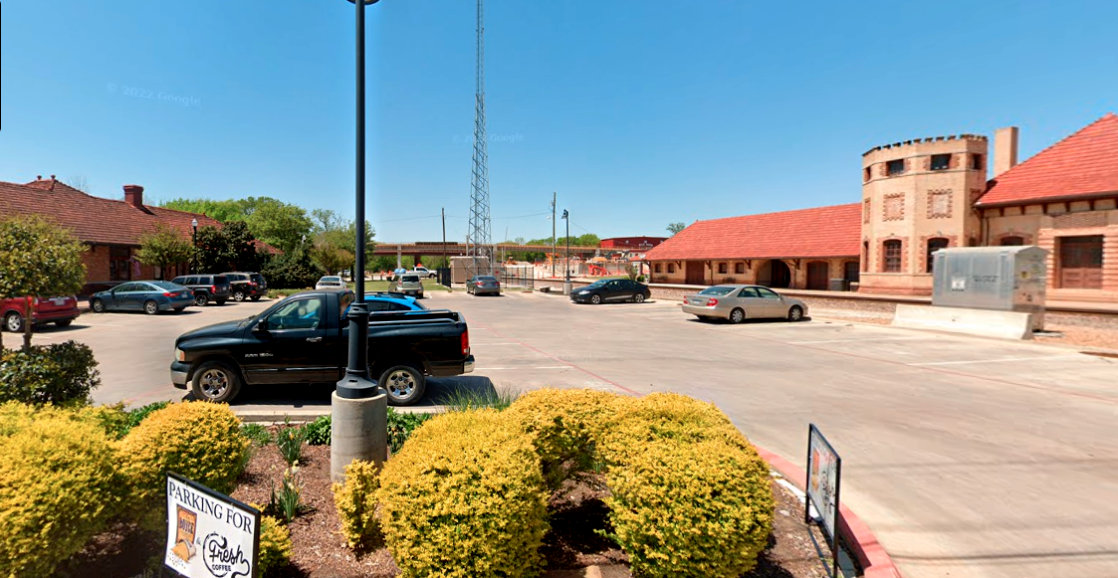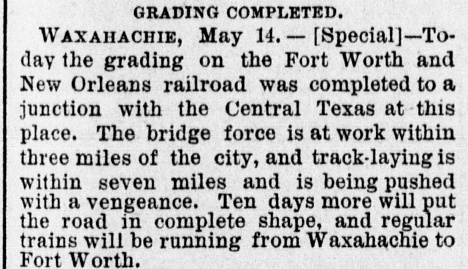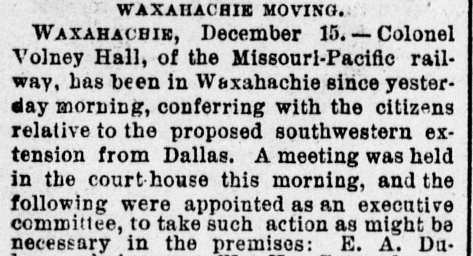Texas Railroad History - Tower 67 and Tower 187 - Waxahachie
Crossings of the Southern Pacific, the
Missouri, Kansas & Texas and the Trinity & Brazos Valley railroads
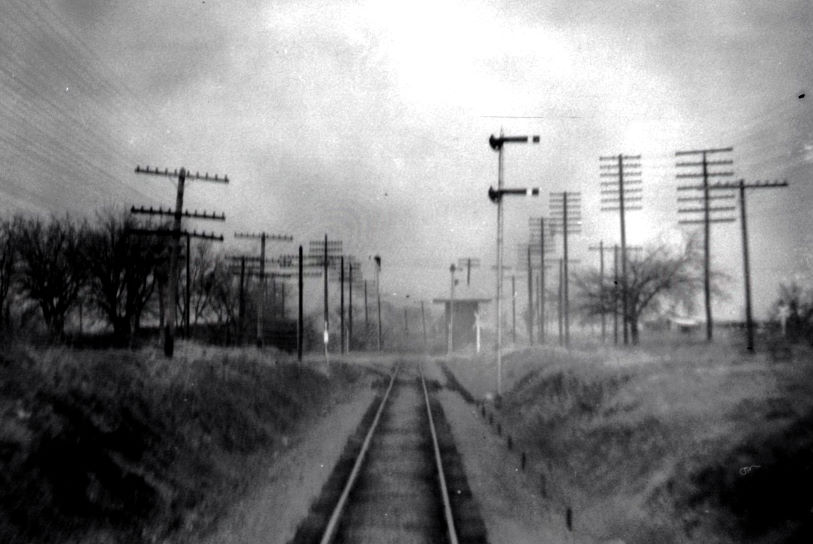 |
Left:
Traveling through Texas in the 1930s, railroad executive John W. Barriger III took this photo of Tower 67 from the rear
platform of his business car. His
train was southbound through Waxahachie on tracks of the Missouri -
Kansas - Texas ("Katy") Railway. Barriger's view is to
the north toward Dallas where his train surely originated. Evidence of the Grand
Ave. crossing of the Katy tracks at grade is apparent from the crossbuck
beside the tracks directly in Barriger's
line-of-sight. The crossbuck visible at the
right edge of the image marks the Grand Ave. grade crossing of the
tracks of the Texas & New Orleans (T&NO) Railroad, a subsidiary of
Southern Pacific (SP.) The source of
the bright
reflection midway up the pole to the left of the Katy tracks is
undetermined, but it likely pertains to the Grand Ave. grade crossing
of the connecting track between the two rail lines southwest of the
tower. The Katy switch
for this connector is plainly visible in the foreground. (photo, John W.
Barriger III National Railroad Library)
In
1927, SP began to consolidate its Texas and Louisiana railroads by
leasing them to the T&NO; this was well before the time of Barriger's photo.
When Tower 67 was commissioned in 1906, the SP tracks had been the
property of a different subsidiary, the Houston & Texas Central (H&TC)
Railway. The H&TC was leased by the T&NO in 1927 and subsequently merged
into it in 1934. |
Right:
This annotated 1938 aerial image ((c)HistoricAerials.com) shows an
overhead view of the scene Barriger captured with his camera. Tracks of
the Katy (pink arrows) and SP (yellow arrows) crossed at an acute angle
at Tower 67 (blue arrow) which sat on the northeast side of the diamond.
The SP tracks were almost precisely on a northwest / southeast alignment
while the Katy ran closer to north / south but had a slight
bearing west of due north. The Katy tracks curved toward due north on
the north side of the tower. Barriger's view
was northward along the Katy from a location near the bottom of
the aerial image. From this vantage point, it is not obvious in his
photo that the
SP tracks passed in front of the tower.
Grand Ave. (green arrows) crossed both
rail lines and the connecting track (red arrows) at
grade. The two crossbucks in Barriger's photo convey the illusion that
the Grand Ave. grade crossing of the Katy tracks (pink circle) was
closer to the tower than the Grand Ave. crossing of the SP tracks
(yellow circle.) The aerial image shows otherwise. |
 |
Settlement of the town of Waxahachie dates back to the 1840s,
and it became the county seat of the newly formed Ellis County in 1850. In the
early 1870s, Waxahachie refused to offer a bonus to the H&TC
as it built north through
Ellis County into Dallas. After the railroad
bypassed Waxahachie, city leaders realized their mistake and proceeded to charter the
Waxahachie Tap Railroad to "tap" the H&TC main line at Garrett, 12 miles east of
Waxahachie. Construction was completed in 1879 and the railroad's name was
changed to the Central Texas & Northwestern (CT&N) Railway. It quickly
became dependent on (and indebted to) the H&TC. Fort Worth
interests sought to connect with this line to provide a better route to
Houston
via Waxahachie and the connection at Garrett. By late 1886, the Fort Worth & New Orleans
(FW&NO) Railroad
had laid tracks between Fort Worth and Waxahachie to connect with the CT&N. It
was soon
acquired by an individual acting as a surrogate for the H&TC, and its operations
were then seamlessly integrated with the H&TC and the CT&N. The H&TC was formally
authorized by the Legislature in 1901 to acquire the CT&N and FW&NO railroads
which comprised the entire line between Garrett and Fort Worth. Long before then (1883), the
H&TC had become owned by SP. In the mid 1920s, SP decided to consolidate its Texas and Louisiana
railroad properties, hence the H&TC was eventually merged into the T&NO.
The next rail line into Waxahachie was the Dallas & Waco (D&W) Railway
which was incorporated in 1886 to build a line
between Dallas and Hillsboro for the
Missouri, Kansas
& Texas (MK&T, "Katy") Railway (renamed Missouri - Kansas - Texas Railway
in 1923.) Several years earlier, rail baron Jay Gould had been named President
of the Katy in December, 1879, a move carefully orchestrated by his henchmen who
had infiltrated Katy management over several years (a plot necessary because Gould
was unable to procure controlling interest in the Katy through the stock
market.) With little stock equity, Gould was vulnerable to collective action by
Katy stockholders. He assured his continued control by signing a contract to
lease the Katy to Missouri Pacifc (MP), a railroad based in St. Louis
in which he had a large ownership position. Gould needed the Katy as part of his
plan to extend his rail empire into Texas using MP as the lead railroad. MP had
no state charter to build rail lines in Texas, so the Katy served that purpose.
Since it was leased to MP, Gould insisted that all construction and operations
(e.g. depots, schedules, etc.) use the MP name publicly even though the title to
new MP tracks in Texas would actually be held by the Katy for compliance with
state law. Thus, the D&W was viewed publicly as sponsored by MP, but legally, it would become a Katy subsidiary
when completed. At Hillsboro, the
D&W would connect to the MP (Katy) main line built by Gould that ran from Fort Worth south to Waco
and beyond.
The D&W was effectively a southwesterly extension of the of the Dallas &
Greenville (D&G) Railway which Gould had chartered to build from
Greenville to Dallas, construction publicly
attributed to MP. Gould elected to charter the D&W to take over construction
from Dallas to Hillsboro so that the D&G project could be wrapped up in advance
of formal acquisition by MP (actually purchased by the Katy.) The purchase occurred on
December 2, 1886, the day the D&G officially completed the line into Dallas.
Above Left and Middle: The
Galveston Daily News of May 15, 1886
reported that the FW&NO grading was completed to the point
where it would connect directly into the CT&N ("Central Texas") line at
Waxahachie. The
same article continued by favorably reporting on the plan for the
"Dallas and Greenville branch of the Missouri-Pacific railroad" to pass through
Waxahachie on a route from Dallas to Waco. The article projected the extension
would be built by the D&G, but the D&W was chartered for this purpose seven months later in December,
1886.
Above Right: The
Galveston Daily News of December 16, 1886
reported on the formation of an executive committee in Waxahachie to take "such
action as might be necessary" to facilitate construction of the D&W into town,
e.g. rights-of-way, land for a depot, roads to access it,
etc.
Below Left:
The September 6, 1887 issue of the Brenham Daily
Banner reported that the D&W had "about compleded" (sic) grading to
Waxahachie, once again publicized as a MP effort.
Below Middle: The
Fort Worth Daily Gazette of March 15, 1888
reported that confidence in the completion of the D&W into Waxahachie by
September was driving activity in the local real estate market. The arrival of
D&W tracks into Waxhachie would be delayed more than a year beyond September, 1888.
Below Right: Construction
of the D&W route
from Dallas had reached Lancaster and stopped. The
Corsicana Observer of June 14, 1889
reported that MP would soon resume building from Lancaster to Waxahachie,
a segment that had been graded two years earlier.

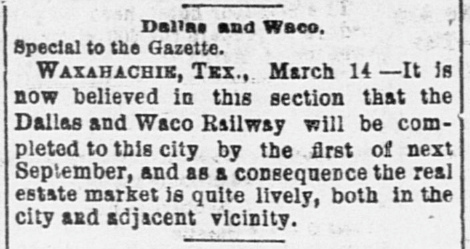

In 1888, Gould lost control of the Katy when its
stockholders were finally able to convene a quorum to fire him for malfeasance
associated with the terms of the lease to MP. They were upset that corporate
accounting for the Katy -- still a publicly traded company -- was being
manipulated by the lease such that Katy profits were routed to MP while the Katy
simply broke even. The new Katy management sought bankruptcy protection and
filed suit to have the lease to MP abrogated (which the Texas
Supreme Court later affirmed.) The D&W
construction paused, but it eventually resumed since it was a separately
chartered corporation, not yet legally part of the Katy or MP. It passed through
Waxahachie in late 1889 or early 1890, crossing the H&TC on the outskirts of
town. By then, the connection at Hillsboro was nearing completion, but the Katy
could not formally acquire the D&W because the courts had determined that the
Katy did not have a valid Texas railroad charter. It was left to the Legislature
to solve the problem in October, 1891 when a new Katy railroad
charter was passed into law. A month later, the Katy acquired the D&W on
November 12, 1891.
As traffic increased over the next decade and a half,
the decision was made to interlock the H&TC / Katy junction in Waxahachie. Tower 67
was authorized
for operation by the Railroad Commission of Texas (RCT) on December 1, 1906 as a
manned, two-story tower housing
a 20-function mechanical interlocking plant. Normally, a simple crossing of two
railroads required twelve functions, hence there were eight additional functions
incorporated into Tower 67's plant. These were most likely for switches, derails and signals
associated with a connecting track built in the southwest quadrant of the
crossing.
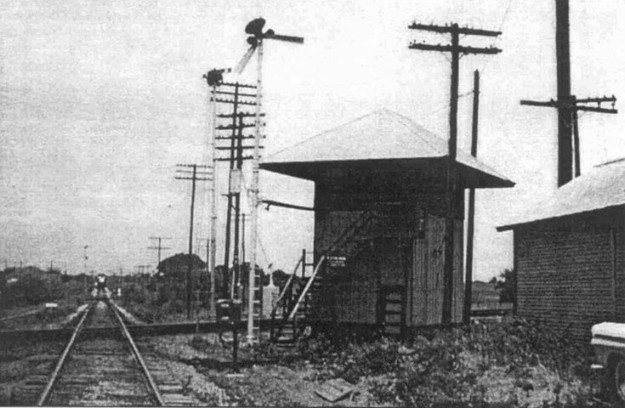
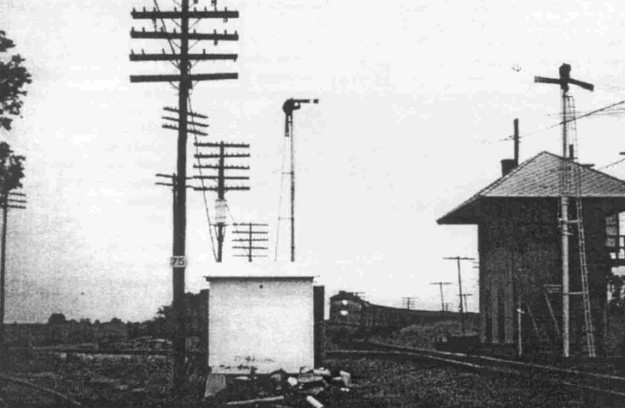
Above: These images of Tower
67 provided by Jim Cooper date from May, 1958 and were printed in the December,
1994 issue of The Clearance Card, the
Journal of the Southwest Railroad Historical Society.
Left: T&NO local freight No. 74 approaches Tower 67
as it returns from Fort Worth to Ennis. Right:
Southbound "Texas Special" No. 1 approaches
Tower 67 on the Katy line. The white equipment cabinet in the foreground
eventually housed the automatic interlocker that replaced Tower 67's plant
in 1958. Whether it was active when the photo was taken is undetermined.
The third railroad into Waxahachie was the brainchild
of native Texan Benjamin Franklin Yoakum, the chief executive for two
significant Midwest railroads: the
St. Louis & San Francisco ("Frisco") Railway and the Chicago, Rock Island
& Pacific ("Rock Island") Railroad. Rock Island had built
into Fort Worth from Oklahoma in 1893, and the Frisco had built from Oklahoma to Carrollton
on the outskirts of Dallas in 1901. This gave Yoakum a healthy presence in north
Texas and motivated his decision to compete with SP along the Gulf Coast. To this
end, he began planning to build or acquire individual railroads to form a
network that would extend from
Brownsville to New Orleans via
Houston. This enterprise became known by its
marketing name, the Gulf Coast Lines (GCL). To connect his Frisco and Rock
Island tracks in north Texas with the GCL at Houston, Yoakum sought to build his own Fort
Worth - Dallas -
Houston line. The first stage was Rock Island's Fort Worth - Dallas line
built in 1903. After considering several options,
Yoakum initiated the Dallas - Houston segment by arranging for Edwin Hawley to
buy the Trinity & Brazos Valley (T&BV) Railway, a small short line railroad
operating between Mexia and
Cleburne. Hawley was a well known railroad
investor,
the principal owner and financier of the Colorado & Southern (C&S) Railway.
Teaming with Hawley added financial heft to Yoakum's railroad play in Texas, and
having the C&S buy the T&BV in 1905 gave Hawley skin in the game since it would
eventually yield a Denver - Galveston route. Hawley
immediately sold an undivided half-interest in the T&BV to Rock Island.
Yoakum was on the C&S Board of Directors and he personally signed a contract
with C&S to lead and execute the Dallas - Houston construction effort. After
modifying the T&BV's
charter to authorize the project, Yoakum extended the T&BV tracks east from
Mexia to the community of Brewer, which he incorporated as the town of Teague (Yoakum's
mother's maiden name.) Yoakum commenced building north and south out of Teague which is roughly midway between Dallas and Houston.
Yoakum was able to avoid building all the way into Dallas by negotiating a trackage rights agreement to
access Dallas from Waxahachie over the Katy's tracks.
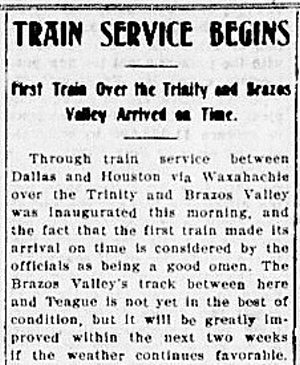 |
With the new T&BV extension east from Mexia, trains began operating between
Cleburne and Teague on March 16, 1906. Yoakum focused his resources on
construction south from Teague to Houston while negotiating trackage
rights between Fort Worth and Cleburne on the Gulf, Colorado & Santa Fe
Railway. This enabled him to begin Fort Worth - Houston service on
January 28, 1907 over the T&BV between Cleburne and Houston via Teague.
Completing the tracks to Houston enabled resources to be
redirected to the construction effort north of Teague. Service between
Dallas and Houston via Waxahachie commenced on July 1, 1907.
Left: The
Waxahachie Daily Light of July 1,
1907 reported that through train service between Dallas and Houston had
been inaugurated earlier that day.
The track connection
between the T&BV and the Katy at Waxahachie was a main-to-main switch
adjacent to the cemetery west of downtown. Southbound trains could
continue on the Katy to Hillsboro or switch to the T&BV tracks for the
trip to Houston. Since two railroads were involved, the nature of the
signals and traffic mix dictated that all trains stop
at the switch before proceeding. By early 1908, the railroads were
considering a revision to their track arrangement to extend the
T&BV nearly a mile farther northwest to Tower 67. There, an
interlocked switch would be used to eliminate the requirement for all
trains to stop.
Right: There's no
evidence that extending the T&BV to Tower 67, a change "soon to be made",
was ever implemented.
(Waxahachie Daily Light,
August 2, 1908.) |
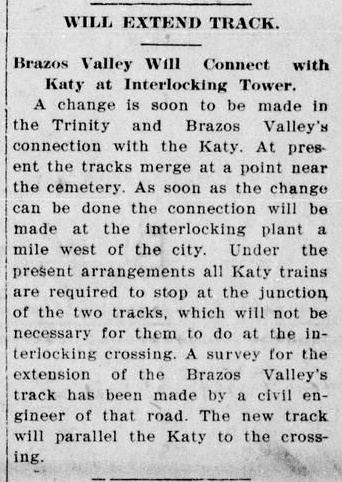 |
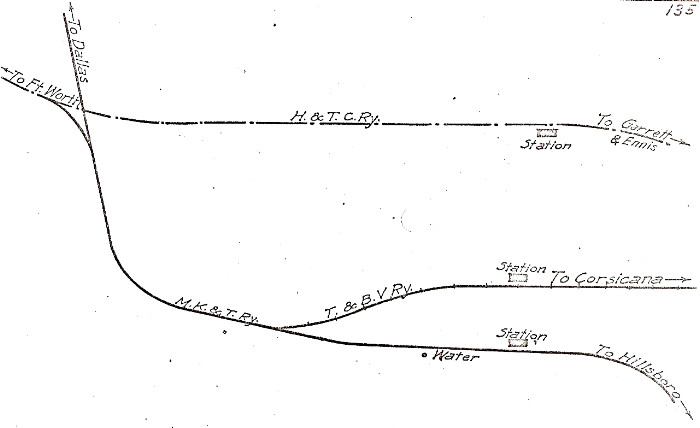 |
Left: This
1915 track chart (not to scale) of Waxahachie was produced by the Katy's
Office of the Chief Engineer. (Ed Chambers collection)
Writing about the T&BV's Dallas - Houston line in his
reference tome A History of the Texas Railroads
(St. Clair Publishing, 1941), author S. G. Reed describes the T&BV's new
operation favorably...
"It was the short line between
these North and South Texas cities and soon became a strong and successful
competitor for both passengers and freight service. At that time, the Frisco
controlled the Rock Island, which two lines on the north and the Gulf Coast
Lines on the south were valuable feeders and for several years, the road was on
a paying basis. Its General Freight and Passenger Agent then was W. C. (Bud)
Connor. About that time, the "forwarding agents" began operating "package cars"
from the Gulf ports. The other railroads were not enthusiastic over this plan of
a reduction in freight charges on the heavy less than carload tonnage from
Atlantic Seabord Territory and did not encourage such operations. But Bud, with
a new road, had nothing to lose as he had not been handling the less than carload
traffic and could not expect to handle much of it against the old lines, so he
joined hands with the package car operators and assisted them in establishing
cars to Dallas and Fort Worth. During one year they handled 1,800 of such cars
and admitted that this traffic more than paid their entire operating expenses." |
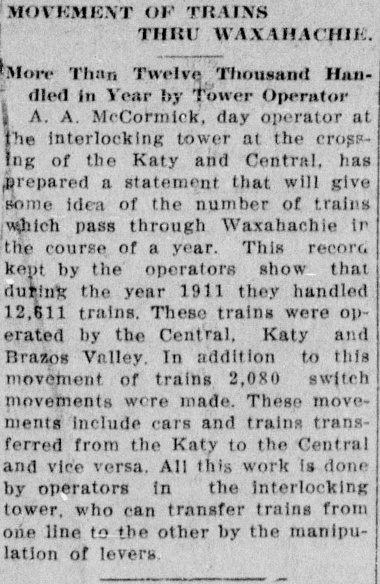 |
Left: The
Waxahachie Daily Light of January 20, 1912 carried this story
about the volume of traffic being handled by Tower 67.

Left: The
Galveston Tribune of March 4, 1914
reported that RCT would hold a meeting on March 10 to review 33
propositions pending before the Commission. Among them was a proposed
interlocker for the Katy / T&BV switch at Waxahachie (incorrectly
reported as a crossing.)

Left: The
San Antonio Express of March 12,
1914 noted that during the March 10 meeting, the T&BV had
objected to the need for an interlocking tower at the Katy / T&BV
switch.

Left:
As reported by the
San Antonio Express
of March 14, 1914, the Commission ordered that the proposal for an interlocking plant at
the Katy / T&BV junction at Waxahachie be "held under advisement." |
 |
Left: Only a
week after RCT's order postponing a decision on the proposed
interlocking for the Katy / T&BV switch, the March 20, 1914 issue of
Railway Age Gazette carried
this note about the railroads' plan to collaborate on a new block
signaling system for the line they shared to Dallas. The switch would be incorporated into the new
signaling system. The project was quickly doomed by the T&BV's receivership. |
The T&BV had reliable business carrying Frisco and
Rock Island traffic
between north Texas and Houston, but it was not enough to sustain the entire
railroad. The Teague -
Cleburne tracks were not profitable, and there was very little local traffic
along the main line. Its only towns of any size, Waxahachie,
Corsicana and
Teague, were small and did not generate the level of freight commerce and
passenger traffic needed to reach profitability on a consistent basis. In June, 1914, only three months after the RCT meeting,
the T&BV was placed in receivership. The Federal judge overseeing the case
canceled all of the T&BV's trackage rights agreements which devastated its
operations. Waxahachie and Cleburne became its farthest operational endpoints to the north, as
was
Houston to the south. Direct service facilitated by trackage
rights into Dallas, Fort Worth and Galveston
was no longer available on the T&BV.
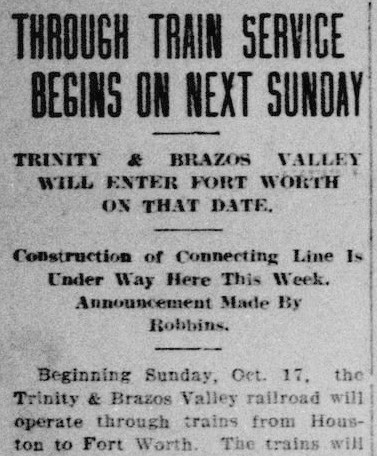 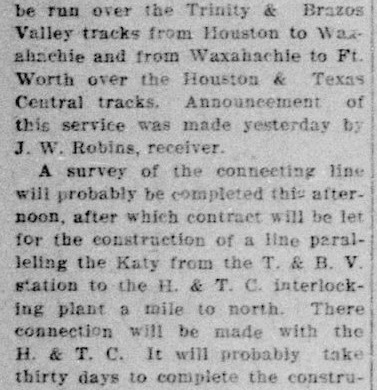 |
The following year, the bankruptcy judge allowed the T&BV to sign trackage
rights agreements with SP for access to Fort Worth from Waxahachie on
the H&TC, and to Galveston from Houston over tracks of another SP
subsidiary.
Left:
On October 11, 1915, the
Waxahachie Daily Light
reported that the T&BV would begin operating Houston - Fort Worth
service via Waxahachie in six days using the SP connection at Tower 67.
It seems unlikely that a line "paralleling the Katy" to the tower was
ever built. No direct evidence has been found, and the function count for the
interlocking plant at Tower
67 never changed. A construction project would have been hard to fund
anyway during receivership, thus all trains still had to stop at the switch.
Although the T&BV had originally used Santa Fe trackage rights between
Fort Worth and Cleburne to operate its Fort Worth - Houston service via
Teague, it appears that in the years leading up to receivership, the
T&BV had preferred routing such traffic via Dallas using the Rock
Island's tracks between Dallas and Fort Worth. Because of Fort Worth's
important rail connections to the north and west, particularly a line
owned by C&S to Denver, it was advantageous for the
T&BV to seek Receiver approval to operate direct Fort Worth - Waxahachie
- Houston - Galveston service using SP trackage rights at both ends. Use of the Katy tracks to
Dallas did not resume until the bankruptcy ended in 1930. |
The receivership ended in 1930
when a new company, the Burlington - Rock Island (B-RI) Railroad, was
created to own and operate the T&BV rail lines.
Burlington had acquired the C&S in 1908, hence B-RI was owned
jointly by Burlington and Rock Island.
The railroads alternated taking the lead in managing B-RI over five year
periods. Burlington's operations were conducted though a C&S subsidiary, the Fort Worth & Denver
City (FW&DC) Railway. In 1931, the FW&DC and Rock Island jointly leased the
B-RI tracks north of Teague, creating what became known as the Joint Texas
Division. B-RI quickly pared its unprofitable routes, abandoning the
tracks from Mexia to Cleburne in stages beginning in 1932. The last stage to be
abandoned was
the Mexia - Hubbard segment in 1942.
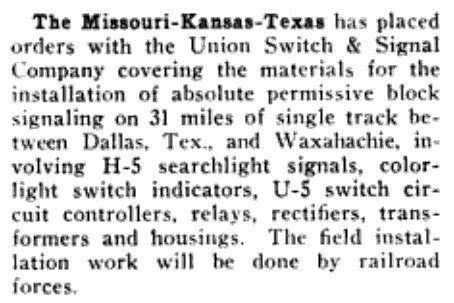 |
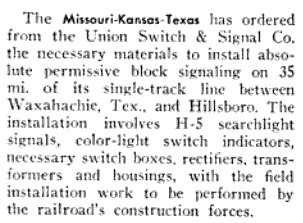 |
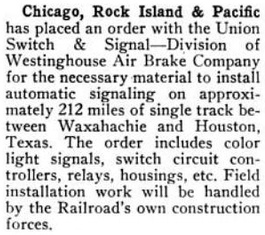 |
Left
to Right:
Railway
Signaling, January, 1946
Railway Age, June 26, 1948
The Signalman's Journal,
January, 1952 |
| Above:
In the latter 1940s and early 1950s, signaling upgrades on the Katy and
B-RI improved operations considerably. The Katy / B-RI switch became
remote-controlled as part of the 1946 upgrade to the signaling on the
shared track to Dallas. |
B-RI resumed the T&BV's Katy trackage rights arrangement
from Waxahachie into Dallas but it dropped the
rights on SP's tracks to Fort Worth. Service to Fort Worth went via
Dallas. Routing through Teague and Cleburne was no longer an option
since much of that route was already in abandonment proceedings.
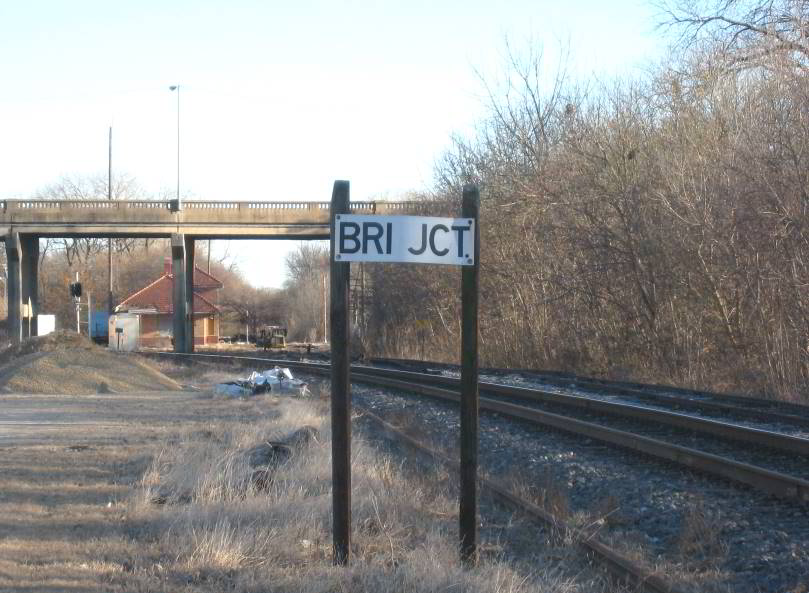 |
The B-RI / Katy switch near the cemetery became known as BRI Junction.
When it became remote-controlled, southbound trains could proceed from Tate (the first
siding north of Waxahachie) to BRI Junction without train order
authority.
In 1950, the railroads jointly leased the B-RI tracks south of
Teague and took over all track maintenance. At this point, the B-RI
corporation no longer served any purpose. It had no tracks to manage and
it had never owned any rolling stock. In 1964, B-RI was put into foreclosure so the parent
railroads could buy its assets and formally dissolve the corporation.
In 1976, the Mexia - Teague segment was abandoned, the last T&BV
track not part of the main line. Burlington was left with exclusive use of the main line
when Rock Island went bankrupt in 1980.
Left: The Katy / T&BV switch near the cemetery
was the original location of BRI Junction, but the switch was moved a
quarter mile southeast, closer to the Katy depot (in the distance), when
a new connecting track was built sometime after 1981. This facilitated
removal of the former T&BV track between the B-RI depot and the cemetery
switch. It is unclear whether Rock Island's bankruptcy a year earlier
played any role in this change, but there were no longer any customers
along that segment (if there ever had been.) Although the Katy tracks
from Waxahachie to Hillsboro are long abandoned, the switch remains
intact with the "straight through" route now the former B-RI
main line. The Katy side of the switch (the righthand track in
this image) is simply a 900-ft. stub track that ends beneath the U.S. 77
overpass. (Jim King photo, 2008) |
Union Pacific (UP)
acquired MP in 1982, and in 1988, it acquired the Katy and merged it into MP.
This was about a hundred years after the Texas Supreme Court had nixed MP's
lease of the Katy. MP proceeded to pare back its newly acquired
Waxahachie - Hillsboro line by abandoning a 10-mile middle segment between
Italy
and Nena in 1990. The tracks to Nena, 4.5 miles south of Waxahachie, were
retained to serve a local customer, while Italy continued to be served by local trains
out of Hillsboro. The 18-mile Italy - Hillsboro segment was abandoned in 1992,
and the Waxahachie - Nena segment was abandoned in 2005.
UP sold the Katy
rails north from
Waxahachie to Dallas to Burlington Northern Santa Fe (BNSF), successor
to Burlington Northern. The Katy route into Dallas has been combined with the
former B-RI line from Waxahachie to Houston to form a continuous Dallas - Houston
BNSF main line. UP merged with SP in 1996, and UP / SP / MP operations were
consolidated under UP's name. SP's T&NO
subsidiary had been dissolved in
1961 and its assets merged directly into SP. UP continues to operated the former T&NO route through Waxahachie.
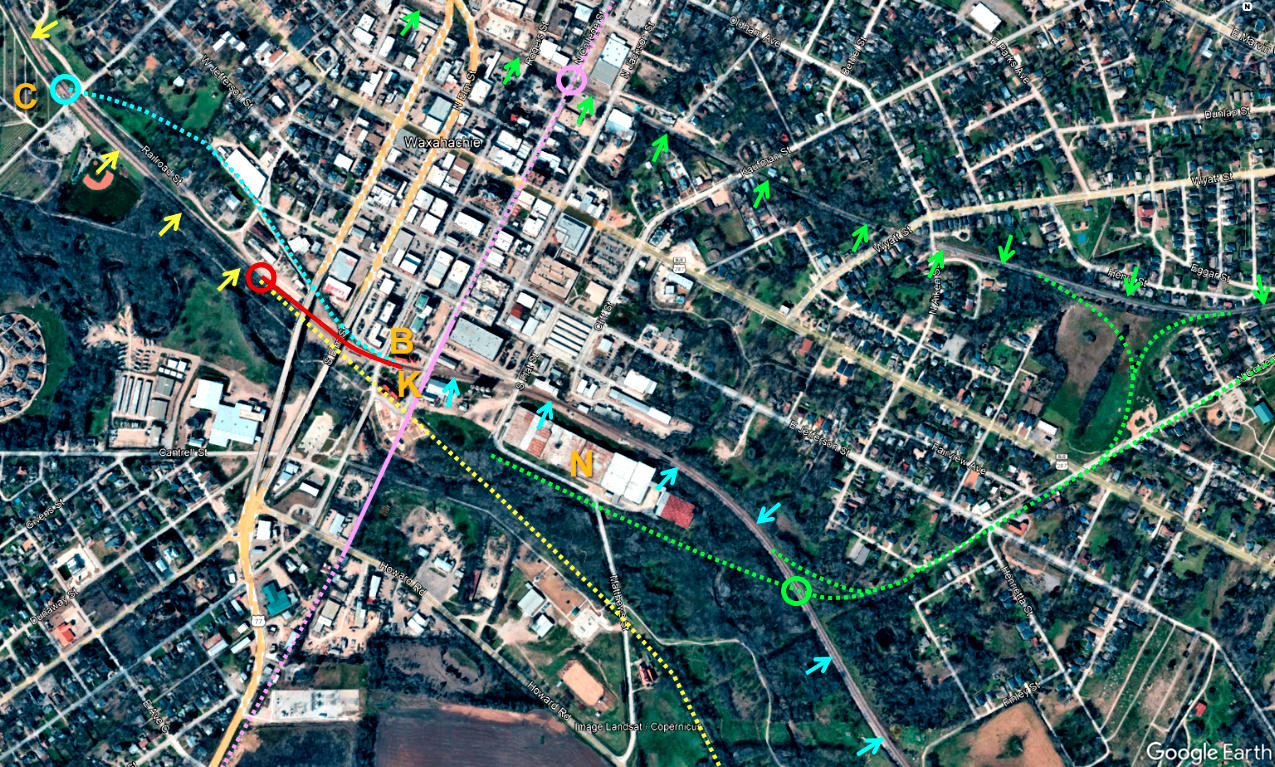
Above: This recent Google Earth satellite image of
Waxahachie is annotated to show the evolution of the track arrangement through
town. The Tower 67 crossing is not visible -- it is off the upper left corner of
the image slightly less than a mile beyond the cemetery ("C"). Originally, a
switch (blue circle) adjacent to the cemetery was the connection for the T&BV
tracks (blue dashes) off the Katy main line (yellow arrows.) The T&BV tracks
curved away from the Katy and then curved back toward downtown to pass by the
B-RI depot ("B") which still stands. This segment (blue dashes) was abandoned
sometime after 1981 because a new connection (red line) had been built between the Katy
tracks and the B-RI depot. This resulted in the relocation of BRI Junction (red
circle) a quarter mile closer to the Katy depot ("K") which is still standing.
The Katy tracks (yellow dashes) south of Waxahachie (abandoned c.2005) passed in
front of the Katy depot. South of the B-RI depot, BNSF's former T&BV tracks
(blue arrows) remain intact to Houston. The former SP tracks (green arrows) now
owned by UP continue off the top of the image and converge west-northwest to a
crossing with BNSF's ex-Katy tracks at Tower 67. From there, the UP tracks
continue west to Fort Worth. To the east, UP's tracks merge into its Dallas -
Houston main line at Garrett, twelve miles east of Waxahachie. SP built a spur
(green dashes) that went southwest to reach an exchange track with the T&BV.
This spur also served the National Compress facility ("N") which required a
grade crossing of the T&BV tracks. That crossing became the site of the Tower
187 interlocking (green circle.) SP's entire spur serving National Compress and
the B-RI exchange track is abandoned, but precisely when this occurred is undetermined.
The Texas Electric (TE) Railway interurban served
Waxahachie on a route from Dallas to Waco.
The tracks (pink dashes) reached Waxahachie c.1912 and ran north / south on
College St. The TE crossed the T&BV and Katy
railroads on a lengthy viaduct (solid pink line) which no longer stands. The TE
tracks crossed the T&NO at grade (pink
circle) but the crossing was not
interlocked. Instead, there was a gate and signals to warn traffic on College St. of an approaching T&NO train. Since the
TE rails were on College St., the TE respected the gates and signals as would
any other vehicle, hence an interlocker was unnecessary. A 1946 T&NO Employee
Timetable (ETT) simply noted "All trains must approach Texas Electric crossing,
Waxahachie, with caution."
Below: A TE interurban car
comes off of the viaduct heading northbound. The pyramid-shaped roof to the
right of the car is the top of the Katy depot. In the background, between the
pyramid and the chimney to its right, the top of the ornamental tower of the
B-RI depot is visible. Another portion of the B-RI depot roof is visible between
the interurban car and the pyramid. The photo was taken by John F. Humiston on
July 1, 1948 and appears in Texas Electric Railway
by Johnnie Myers (Bulletin 121, Central Electric Railfans' Association.) The
inside back cover of this book has a photo of the TE grade crossing of the T&NO
on College St. Passenger service on the TE was terminated at the end of 1948 and
the tracks were abandoned.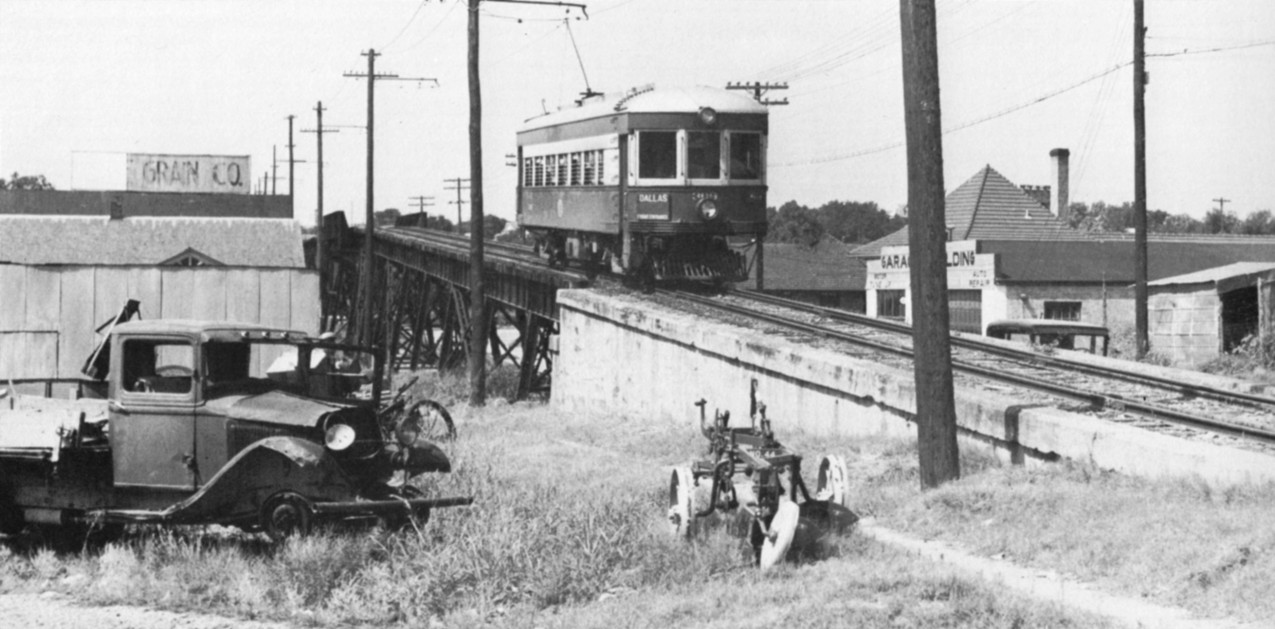
Jim Cooper describes Tower 67's operation...
Southward trains activated a light on the
panel and rang a bell in the tower upon passing the south end of the passing
track at Sterrett (the second passing track north of Waxahachie.) Northward
Katy trains announced themselves in the same way at the north
end of the passing track at Nelson (the first passing track South
of Waxahachie on the Katy) as did northward BR-I trains at the north
end of the passing track at Bardwell (the first passing track
south of Waxahachie on the BR-I). T&NO trains activated the
light and bell about 2 miles east and west of the tower.
The crossing was protected by derails on
the main tracks in all four directions and from the transfer track onto the main
lines. In order to give a clear signal for any movement, the derails appropriate
for the movement permitted by the clear signal must be closed and locked in
place and derails for conflicting movements must be open. When a clear signal
was displayed for a movement on a particular route, a clear signal could not be
given for any other movement. That conflicting routes could not be cleared at
the same time was insured by a system of rods moving with the levers operating
the derails, locks, and signals that functioned much like a lock and key in that
parts would not fit mechanically to permit improper or conflicting routes.
The tower was a 24-hour train order office on both the MKT
and the T&NO. Although there were also three tricks (shifts)
of train order operators at the BR-I depot in Waxahachie that copied
most of the orders for BR-I trains, occasionally BR-I trains would
be given orders at Waxahachie Tower. Both the tower and the BR-I
depot handled Western Union messages at nights and on weekends
when the downtown Western Union office was closed. Intra-company
messages for both the Katy and the T&NO depots passed through
the tower. In the late 1940s and early 1950s between 20 and 30
trains, including 14 passenger trains, were handled daily. During
the wheat rush in early summer the traffic was heavier. The tower
was replaced by an automatic system in 1958 at which time the
train order office was moved to the Katy depot just south of downtown
Waxahachie. (from The Clearance Card,
December 1994, Journal of the Southwest Railroad Historical Society)
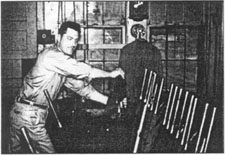 |
Left:
Operator Davis is lining up a route for an oncoming train. The view out the
far window is south
down the Katy. The pendulum for the office clock can be seen above the
time-release clock (upon which a coat is hung). If a proceed signal was
improperly displayed, a new route could not be aligned until 45 seconds
elapsed after starting the time release. This seemed like a long time
when an engine is sitting at the home signal blowing its whistle. (Jim
Cooper photo)
Right: Tower 67
operator F. J. Davis entertains Richard Cooper, son of Jim Cooper, in
December, 1957.
(Jim Cooper photo) |
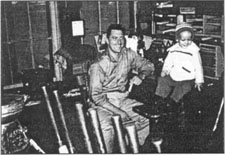 |
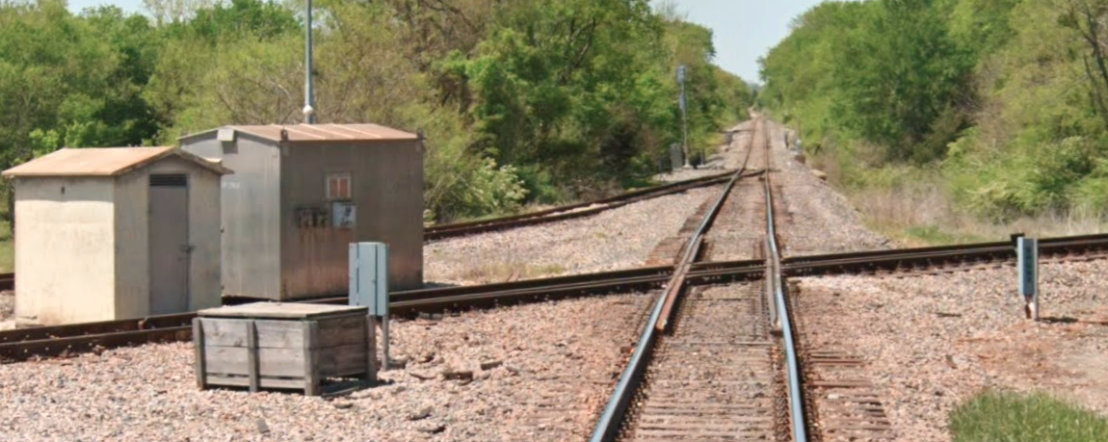
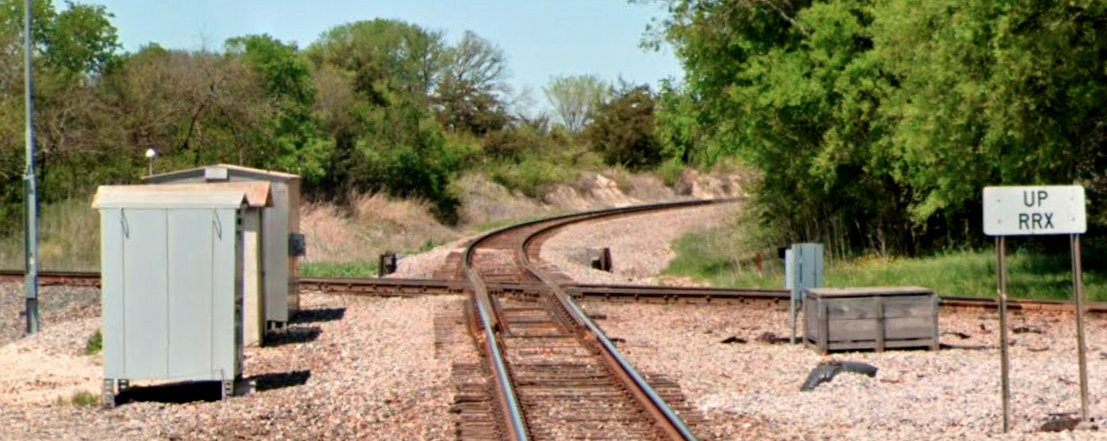
Above Left: This
April, 2022 Google Street View
of the Tower 67 crossing faces northwest along UP's former T&NO line to
Fort Worth. BNSF's former Katy tracks cross in front of the equipment cabinets
and the exchange track is visible behind the cabinets. The equipment hut to the
left appears to be the same one that's in the Jim Cooper photo above. The hut to
the right has interlocker override controls mounted on the outside. In this
view, the tower sat in the lower right corner with its long side parallel to the
Katy tracks.
Above Right:
This view is to the north along BNSF's former Katy tracks. The tower was located
near the clump of trees to the right. (Google Street View, April, 2022)
Below Left: The Waxahachie B-RI depot has the appearance
of being abandoned
in this 1974 photo by Stephen Smith, but it remained in use by its owner, the Nay
Company, a general contractor specializing in agricutural and commercial
building design. The load of pipe and assorted refuse around the building
suggests some kind of construction or renovation activity was underway.
The company acquired the depot in 1963 when it was abandoned by the railroad.
Below Right: This 2022 Google
Street View from the opposite side of the depot shows its present condition. It
underwent a major rennovation in 2008 and serves as the Nay Company's
headquarters.
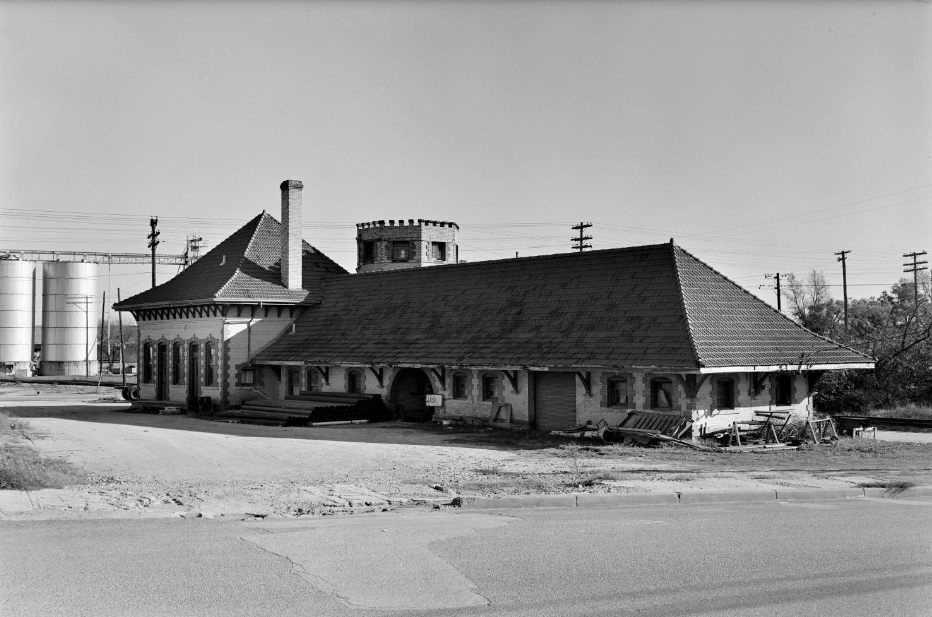
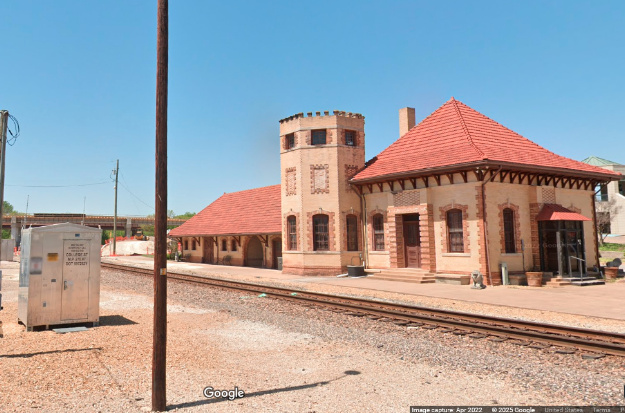
Sometime in the 1890s, National Compress Co. built a
cotton compress in downtown Waxahachie near the Katy depot. The compress appears on the 1898 Sanborn Fire Insurance Map of Waxahachie served by spur
tracks from both the Katy and the H&TC. The Katy spur was relatively short since
the main line was close by, but the H&TC spur needed nearly a mile of track to
reach the compress. When the T&BV built into Waxahachie in 1907, it crossed the
H&TC spur at grade. As an uncontrolled crossing of two different railroads, all
trains would have been required to come to a complete stop. However, since
virtually all T&BV
trains would have stopped at the depot less than a half mile from the crossing, this may
not have created much additional delay in those days. Although the T&BV main line ran along the north side of the compress,
it did not have a spur to serve the compress because the Katy spur already
occupied the real estate on that side of the building.
Right:
This excerpt from a December, 1959 T&NO ETT describes the operation of the Tower 187 crossing where T&NO's National
Compress spur track crossed the B-RI main line. This interlocker design
was generally called a ground-lever interlocking because the signals on
the main track were controlled by use of the "ground-throw switch" which
also released
the derails on the T&NO track. Since T&NO crews were responsible for
operating this switch, there was no need for signals on the T&NO
spur. STOP signs were sufficient to warn approaching T&NO trains of
their obligation to operate
the switch. At all other times when the crossing was not in use by T&NO,
the signals were set to allow unrestricted B-RI movements
over the diamond.
Documents in the RCT archives maintained
at DeGolyer Library, Southern Methodist University shed light on the
evolution of the Tower 187 interlocking. On May 21, 1942, B-RI requested
approval to install an interlocking for a "gate and derails" at the
National Compress spur crossing. RCT assigned #187 to the interlocking
and subsequently approved its design on July 11, 1942. Nearly a year
later in a letter to B-RI dated March 17, 1943, RCT requested a status
report on Tower 187's construction. B-RI responded with a letter dated
March 23, 1943 stating that the Tower 187 interlocker was not under
construction because the War Production Board had denied the
application. As this excerpt (right) from the 1959 T&NO ETT shows, the
interlocking was eventually built, but the precise date it became
operational is undetermined. |
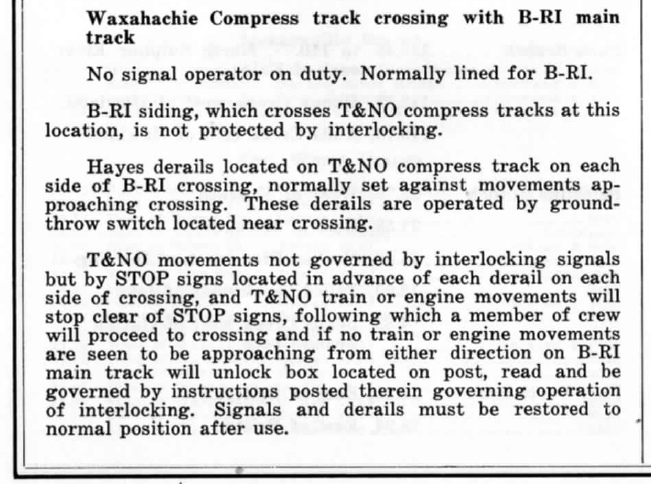 |
 |
Left: This
1956 aerial image ((c) HistoricAerials.com) has been annotated to show
the track topology at Tower 187 (green circle) where the B-RI main line
(blue arrows) and an adjacent siding crossed the T&NO spur (orange arrows)
to the National Compress facility. The siding was B-RI's endpoint for a T&NO
/ B-RI exchange track (pink arrows) that came off the T&NO spur. The
siding was parallel to the B-RI main line and extended far enough south
to cross the T&NO spur at Tower 187. As explained in the T&NO ETT
(above), "B-RI siding, which crosses the T&NO compress tracks at this
location, is not protected by interlocking." This meant that the Tower
187 interlocking only controlled signals on the B-RI main line for its
crossing of the T&NO spur. There were no signals, interlocked or
otherwise, that governed movements on the B-RI siding over the T&NO
spur. |
Below Left: Looking
southeast, a BNSF freight idles next to the abandoned Katy spur
(note rails buried in the ground) on the
north side of the former National Compress site, which is now a warehouse. (Jim King photo, 2008)
Below Right: This
southeast view along the south side of the former National Compress site shows
where the T&NO spur served the compress on an extended elevated grade visible
beside the building. (Jim King photo, 2008)
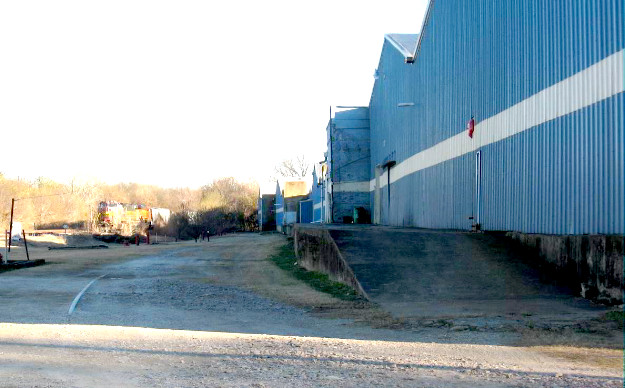
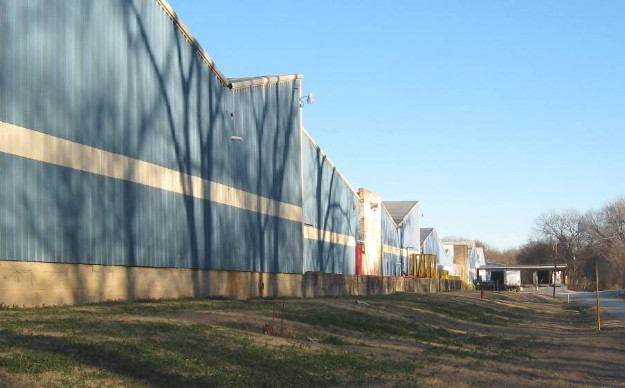
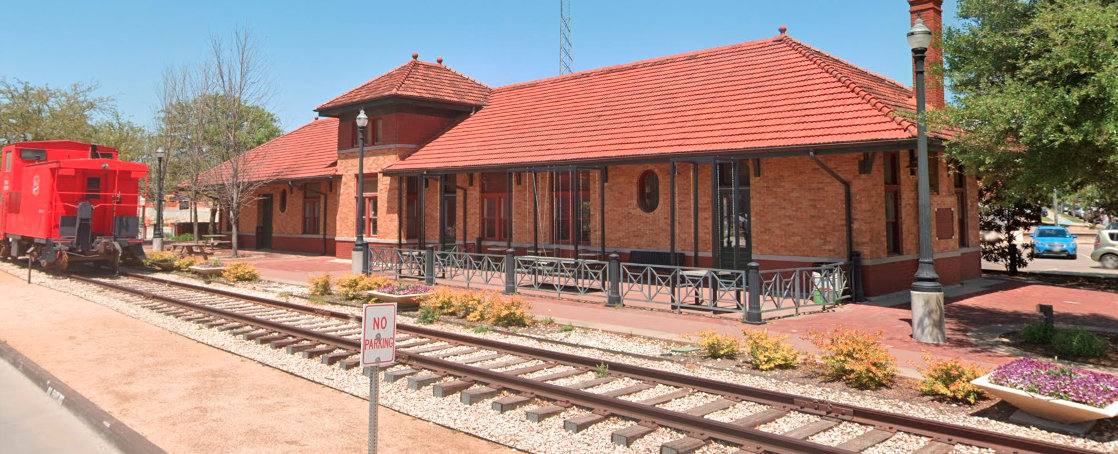
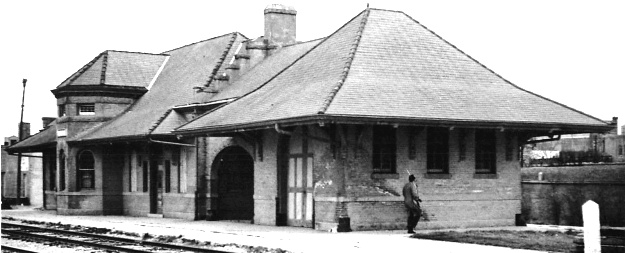
Above Left: The Katy depot underwent a major restoration project in
2008. The project was completed in 2010 and the depot is now the home of Fresh
Market Coffee, a breakfast restaurant. The caboose was acquired in 2011 and sits
on a piece of track placed on the original right-of-way. (Google Street View,
April, 2011) Above Right: The
SP depot in Waxahachie, seen here in 1961, is no longer standing. (H. D. Connor
Collection) Below: The back
of the Katy depot (left) faces the front of the B-RI depot (right.) The BNSF
main line passes between them adjacent to the B-RI depot. This April, 2022
Google Street View was captured from College St., which means that interurban
passengers would have had a similar view.
